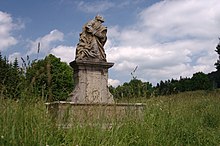Vysoké Žibřidovice
| Vysoké Žibřidovice | ||||
|---|---|---|---|---|
|
||||
| Basic data | ||||
| State : |
|
|||
| Region : | Olomoucký kraj | |||
| District : | Šumperk | |||
| Municipality : | Hanušovice | |||
| Geographic location : | 50 ° 7 ' N , 16 ° 55' E | |||
| Height: | 550 m nm | |||
| Residents : | 90 (March 1, 2001) | |||
| License plate : | M. | |||
| traffic | ||||
| Street: | Staré Město - Hanušovice | |||
| Railway connection: | Hanušovice - Staré Město | |||
Vysoké Žibřidovice (German Hohen Seibersdorf , also Hohenseibersdorf ) is a district of the city of Hanušovice in the Czech Republic . It is located five kilometers north of Hanušovice and belongs to the Okres Šumperk .
geography
Vysoké Žibřidovice spreads in the south of the Kłodzko Snow Mountains in the basin of a right tributary of the Krupá . To the northwest rises the Větrovec ( Widkopf or Windenberg 785 m), in the south the Křížový kopec ( Kreuzberg , 690 m), in the southeast the Skřivánčí vrch (627 m) and in the east the Paseka ( Viehbichkuppe , 650 m). To the east, the railway runs from Hanušovice to Staré Město through the Krupá valley, where the Vysoké Žibřidovice train station is also located.
Neighboring towns are Chrastice in the north, Vikantice in the northeast, Rudkov and Habartice in the east, Hanušovice in the southeast, Žleb in the south, Vojtíškov in the southwest, Vysoká in the west and Bystřina and Hynčice pod Sušinou in the northwest. Also to the north-west of the village is the Cibulka desert ( Cibulkafeld ) and in the south-west is the extinct settlement of Christenfeld.
history
The village was probably founded in the course of German colonization at the end of the 13th century and is named after its locator. The first written mention of Syfridesdorph was on May 3, 1325 when Hanß von Wustehube auf Goldenstein gave it to the Kamenz monastery . Later the sovereign bought the place back and Seibersdorf came back to the Goldenstein rule. In 1432 the Hussites devastated the area. To distinguish it from the other Seibersdorf , the village was called Hohenseibersdorf because of its location on the south-western slope of the Větrovec above the valleys of the Krupá, Prudký potok and Zelený potok . Together with Hannsdorf and Waltersdorf , Hohenseibersdorf was again devastated in the second half of the 15th century during the battles for the Bohemian-Hungarian succession. During the subsequent feud between Hynek von Zwole auf Goldenstein and Georg the Elder Tunkl from Brníčko auf Zábřeh , the place was destroyed again and temporarily came under the rule of Eisenberg . The village was rebuilt in the 16th century. At that time, Hohenseibersdorf was a parish village and had a wooden church, the bells of which were made in 1538. In 1630 the parish went out and the place became Protestant. In 1677, Hohenseibersdorf consisted of 35 properties, of which 24 were farms and the remaining farms. The parish was renewed again in 1784. In 1834 510 people lived in the 80 houses in the village.
After the abolition of patrimonial Hohenseibersdorf / Žibřidovice with the district Cibulkenfeld formed a political municipality in the Mährisch Schönberg district . The place belonged to the judicial district Altstadt . In 1880 the village reached the highest population in its history with 624 inhabitants. At the end of the 19th century, the Czech name was changed to Vysoké Žibřidovice . In 1905 the Hannsdorf – Mährisch Altstadt local railway started operating. In 1930 the community consisted of 99 houses and had 522 inhabitants, all but two Czechs and one foreigner belonging to the German ethnic group.
As a result of the Munich Agreement , the municipality was added to the German Reich in 1938 and belonged to the Mährisch Schönberg district until 1945 . In 1939 Hohenseibersdorf had 461 inhabitants. After the Second World War, the German residents were expelled . The settlement of Cibulka was abandoned and demolished.
In 1964 Žleb was incorporated and since 1976 Vysoké Žibřidovice has been a part of Hanušovice . In 1982 only 53 houses were permanently used for residential purposes and Vysoké Žibřidovice had 179 inhabitants. In 1991 the place had 99 inhabitants. In 2001 the village consisted of 33 houses in which 90 people lived.
Attractions
- Church of St. Linhart, the baroque building was built between 1714 and 1721 instead of a wooden previous building and was elevated to a parish church in 1784
- Baroque statue of Christ, called oil father , donated in 1780 by the grandfather of Franz Schubert , the flat dealer Carl Schubert, west of the village on the hill the Olivet ( Olivet ) on the road to Vysoká


